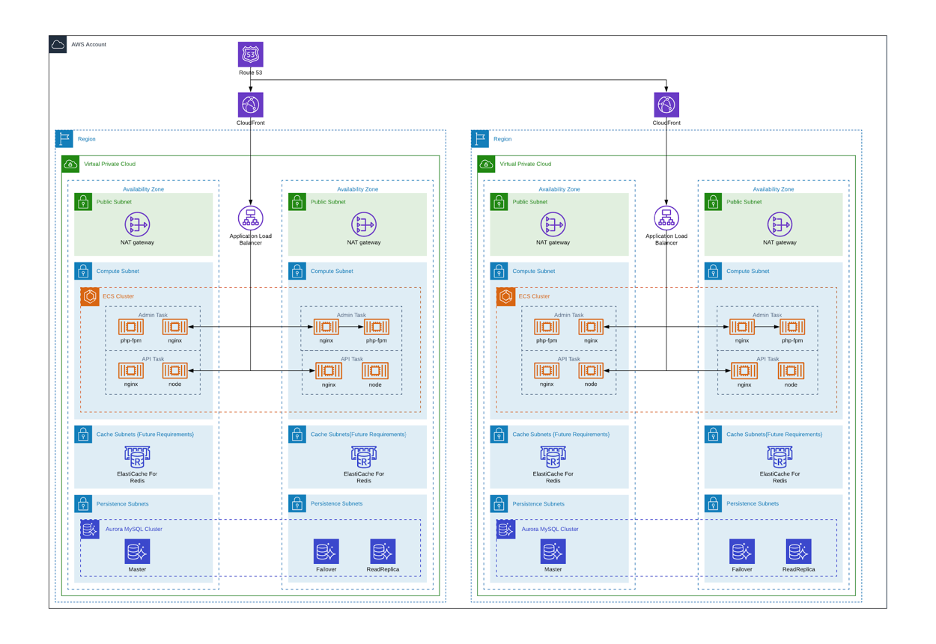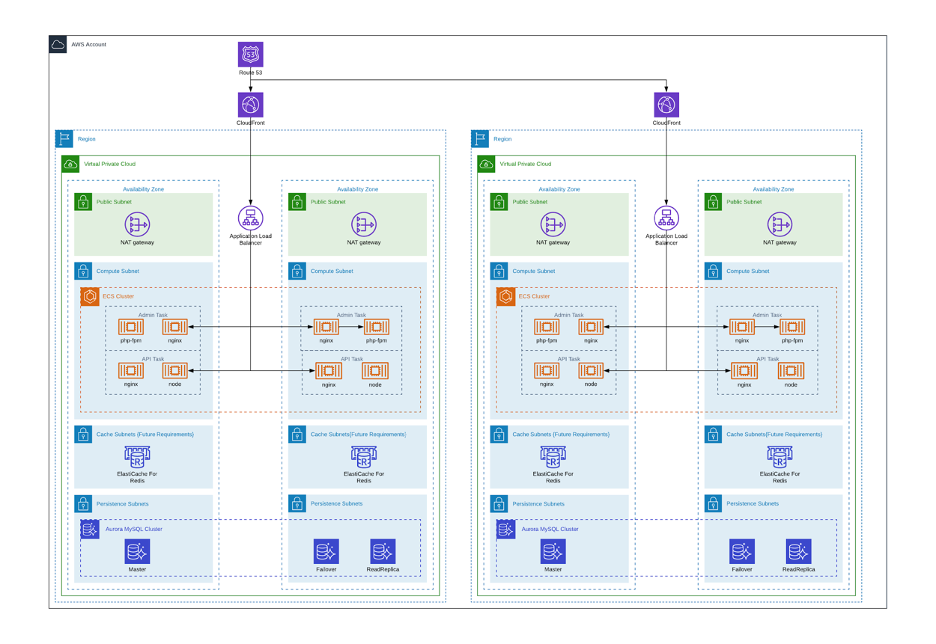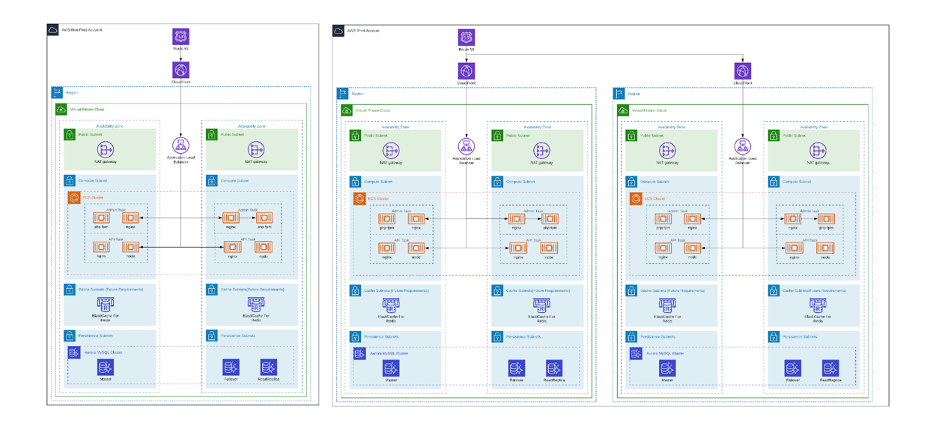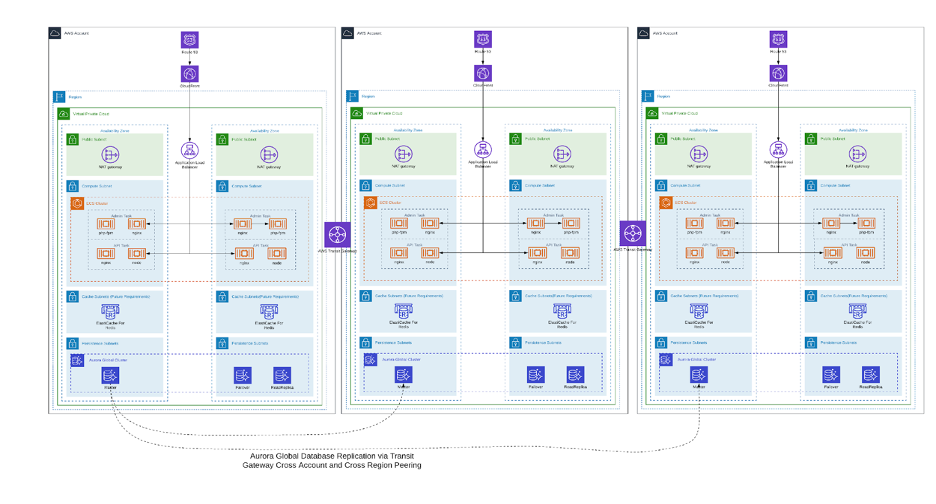If you’re looking to take your SaaS product global using Amazon Web Services (AWS) and want to guarantee that it has the best scalability, compliance management, security and performance, you should follow AWS well-architected principles to ensure a solid foundation. There are five common architecture patterns which are used by global SaaS products of all sizes, from those just starting their transition to the world stage, to major established products. But which infrastructure is right for your product?
In this fifth article of our six-part series, I’ll introduce five architectural patterns that you should be aware of, and explain what they entail, when to use them as well as their pros and cons.
The 5 architectural patterns for building a global SaaS on AWS
Each of the patterns has unique pros and cons for every organization — while some of the more complex and involved patterns may be better for stability and performance, they are harder to run and often require a larger team to operate. When looking to build these architectures, your development and operations teams should weigh the positives of easy implementation and setup against the long-term scalability and power of others. Every company has unique needs, and picking the architecture that suits yours will work best for your company in a successful global expansion. Choosing an architectural pattern does not limit your opportunity to change it over time as you evolve your SaaS product and your business grows.
Architecture 1: Single Account, Single Region
Single account, single region architecture is widely adopted by most SaaS products on AWS. It’s an uncomplicated approach that involves building across multiple availability zones, using edge balancing and caching to enhance performance.

Pros:
- Easy to get started: The simplicity of this architecture makes it easy to get started and deploy quickly.
- Simple Deployment: This architecture pattern streamlines the deployment process by integrating development, testing, and production environments within a single AWS account. This simplifies the overall workflow and reduces the potential for deployment errors or inconsistencies.
Cons:
- Compliance challenges: Depending on the nature of the business, compliance with data protection laws may be difficult to achieve when using a single account for all environments.
- Performance limitations: Even with edge locations, users located far from the main region may experience slower performance due to increased network latency.
- Cost management complexity: With all environments in a single account, it may be challenging to understand the cost breakdown between production and non-production environments, which can make cost management difficult. Tagging can be helpful but it can still be difficult to accurately track expenses and optimize resource allocation.
Architecture 2: Single Account, Isolated Regions
The next more complex option for your global architecture is a Single account, isolated regions model, in which you stick to your single account but isolate each of your regions. This is the same architecture deployed in one account, but across multiple regions that are completely isolated from each other providing added resilience and security.

Pros:
- Simplicity: Implementing a multi-region architecture is a straightforward process. Deployment of environments across regions is also relatively simple especially if the environments have been built with automation.
- Improved scalability: Each region can scale independently based on local demand. This flexibility enables better resource allocation, ensuring optimal performance and user experience across diverse geographical locations.
- Easier compliance: With isolated regions, it's easier to comply with local data protection laws and regulations since each region is separate.
- Regional flexibility: A multi-regional architecture allows for changes based on regional differences, such as language or currency. It allows for localized control and customization, catering to the unique needs of different regions and specific customer requirements.
Cons:
- Duplication of resources: To maintain isolation, all resources need to be duplicated across each region. This can lead to increased costs and may limit the benefits of shared resources.
- Complex IAM configuration: Access to resources needs to be configured in each region separately which can create complications and make management, maintenance, and scalability more challenging.
- Difficulty in measuring costs: Accurately measuring the costs of each region and their split between prod and non-prod can still be an issue with this architecture, as detailed tagging and monitoring is required and needs to be managed and maintained over time.
- Potential security exposure risks: Running multiple regions on one account creates potential security exposure risks if for example a developer's credentials get leaked. A security breach in one region can potentially affect other regions and environments.
- Complex user data portability: Considering compliance and performance needs, users may find it necessary to transfer their data across regions. Since individual user data resides in multiple systems, extracting and relocating it to another region involves customized engineering procedures, thereby increasing the cost and complexity involved.
- Region details visible: The region details are often visible to end users through URLs like app.eu.example.com or app.us.example.com. This may lead to user confusion and may be a concern to some organizations.
Architecture 3: Multiple Accounts, Isolated Regions
The Multiple accounts, isolated regions architecture is an improved model compared to a single account setup. It involves separating production workloads from non-production workloads into separate accounts which allows for better management of access and limits the risk of cross-tenant interference therefore improving security and compliance. Using multiple separate accounts also makes cost allocation more accurate and resource scaling easier. In fact, this model sets the bar for successfully taking a product global.

Pros:
- Regional independence: Since each region is separate it can be scaled independently. This flexibility allows for efficient resource allocation based on regional demands, ensuring compliance, optimal performance and user experience across different geographical locations.
- Simplified IAM configuration: Separating production workloads and non-production workloads into different accounts makes it easier to manage user access. IAM policies can be more granularly defined within separate accounts, reducing complexity and improving security by limiting access to specific environments.
- Increased visibility into costs: Production and non-production costs can be tracked separately without the need for complex tagging. This allows for better cost management and forecasting, as well as proactive cost management through billing alerts.
- Separate AWS Account limits: Takes advantage of separate regional AWS account limits for non-production and production environments. This separation helps ensure that resource usage in non-production environments does not impact the availability or performance of production systems.
Cons:
- Additional overhead: Managing IAM user access across multiple accounts requires more overhead. Proper user provisioning, access control, and role configuration must be maintained across multiple accounts, requiring careful coordination and ongoing management efforts.
- Complex user data portability: Considering compliance and performance needs, users may find it necessary to transfer their data across regions. Since individual user data resides in multiple systems, extracting and relocating it to another region involves customized engineering procedures, thereby increasing the cost and complexity involved.
- Region details visible: With isolated regions, end users may be able to see region details through the URLs such as app.eu.example.com or app.us.example.com, which may be confusing and a concern for some organizations.
Architecture 4: Account per Environment / Region, Isolated Regions
This model involves creating an AWS account for each development, test and each production environment in each region. This ensures the highest level of security and isolation between regions.

Pros:
- Highest level of isolation: By utilizing separate AWS accounts for each environment and region, this pattern achieves the utmost level of isolation and security. It ensures that resources, data, and configurations are isolated from one another, minimizing the impact of potential issues or breaches.
- Ideal for regions with special data protection requirements: The use of separate AWS accounts facilitates more granular access controls which might be required for some regions that are governed by specific regulations or compliance standards. This pattern allows organizations to enforce stricter security measures and ensure compliance with regional data protection laws.
- Separate AWS Account limits: Each environment in each region being deployed in a separate AWS account provides the advantage of distinct AWS account limits. This separation allows for even better resource management, avoiding resource exhaustion or performance degradation in one region affecting others. It also makes it easy to track usage, helping organizations better manage costs.
Cons:
- Complex IAM configuration: Cross-account IAM is required to manage deployments adding complexity and requiring careful coordination and adherence to best practices. It also introduces additional administrative overhead. Proper user provisioning, access control, and role configuration must be maintained across accounts.
- Complex user data portability: Considering compliance and performance needs, users may find it necessary to transfer their data across regions. Similar to the other architecture types, extracting and relocating that data to another region involves customized engineering procedures since individual user data resides in multiple systems, thereby increasing the cost and complexity involved.
- Potential for end-user visibility into regions: Region details may be visible to end-users, such as app.eu.example.com or app.us.example.com, which may be confusing to the customer and/or a concern for some organizations.
Architecture 5: Account per Environment, Regional Replication
This architectural pattern takes it to the next level by deploying development, testing, and each production region into separate AWS accounts and replicating all your data across all of your regions. This does not only result in a high level of isolation and security but also ensures optimal availability and disaster recovery.

Pros:
- Global solution for enterprises: This architectural pattern provides a truly global solution for enterprises, as users can access their data from any region.
- Full regional failover support: With full replication of each region, this architecture ensures high uptime and low customer disruption in the event of an AWS region going down.
- Separate AWS Account limits: As each AWS account has its own account limit, resource management is easier and resource exhaustion or performance degradation in one region affecting others can be avoided. It also makes it easy to track usage, helping organizations better manage costs.
Cons:
- Challenging compliance: As all data is replicated across regions, compliance with data sovereignty and data protection laws can be challenging, making it difficult to provide customized strategies for individual data protection laws.
- Complex network configuration and deployment processes: The network configuration and deployment processes are more complex. Coordinating and synchronizing data transfers and deployments across multiple environments and regions requires careful planning and orchestration to maintain consistency and ensure proper functioning of the application across all regions.
- Increased storage costs: All regions must store data for all regions, which can result in high storage requirements and increased data storage costs.
Choosing the right architecture for your organization
Choosing the right architecture for your organization is crucial for long-term scalability and a smooth launch process for your global SaaS product. However, keep in mind that the architecture pattern you choose today is not set in stone and you will most likely adapt and change it over time as you enter new markets and your SaaS product grows. However, with so many differences in architecture, it can be challenging to make the right choice of where to start. That's why it's best to work with a technology consultant who truly understands AWS and global SaaS launches.
At base2Services, we have a proven track record of assisting organizations like yours with our deep knowledge of AWS, SaaS and our unique DevOps approach to help companies get ready for their step onto the world stage. We can help you choose the right architecture for your business to ensure long-term success.
In our next post, Utilizing AWS Organizations for your multi-account SaaS architecture , we’ll discuss AWS Organizations and how it can help you manage the different architecture patterns we covered today.
If you’re interested in learning how your SaaS business can expand globally, please read our other insightful blog posts in this series that take you through the key challenges to consider and the benefits of AWS Organizations:
- 4 Key Challenges of Taking Your SaaS Product Global – Part 1: Compliance
- 4 Key Challenges of Taking Your SaaS Product Global – Part 2: Security
- 4 Key Challenges of taking your SaaS product global – Part 3: Scaling
- 4 Key Challenges of taking your SaaS product global – Part 4: Performance
- Utilizing AWS Organizations for your multi-account SaaS architecture - NEXT
And, if you haven't already, be sure to watch the videos of our webinar on this topic.
Ready to take your SaaS product to the next level? Contact us today to learn more about how base2Services can help you succeed on a global scale.





